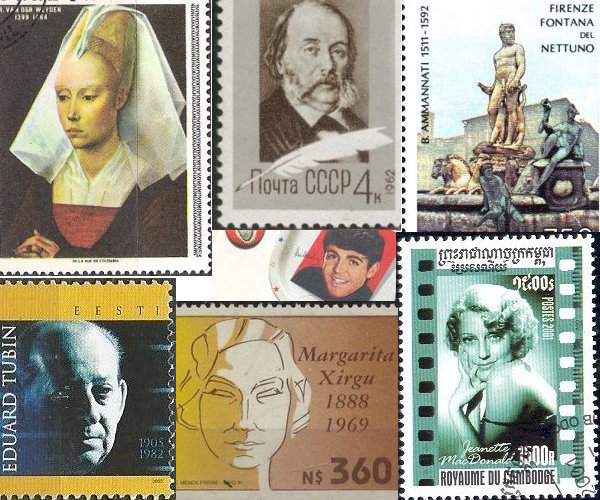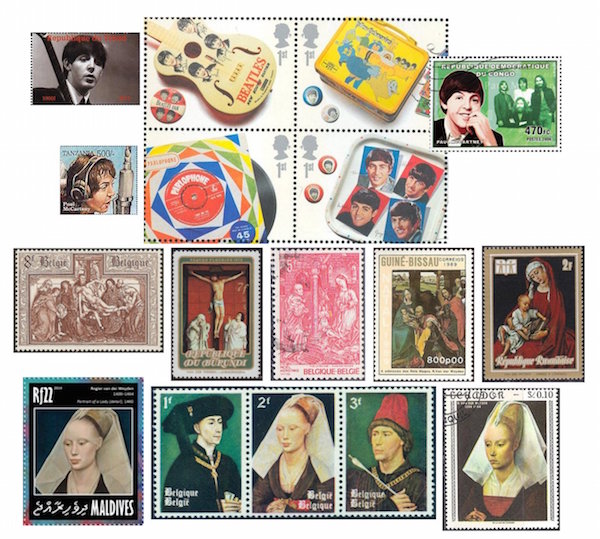The Arts on the Stamps of the World — June 18
An Arts Fuse regular feature: the arts on stamps of the world.

By Doug Briscoe
Happy birthday, Sir Paul McCartney (born 18 June 1942)! I showed a British Beatles stamp here on the anniversary of their historic Ed Sullivan Show appearance. Rather than repeat that one, here’s a block issued in 2007 showing Beatles memorabilia, with a few African McCartney stamps scattered around the edges.

Our dominant figure today, however, quantitatively speaking, is Netherlandish painter Rogier van der Weyden (born Roger de la Pasture in 1399 or 1400), who died on 18 June 1464. I was quite amazed at the volume of worldwide postage stamps showing his work. He was born in Tournai and was named “painter to the town of Brussels”, a position created especially for him, in March 1436. With Jan van Eyck and Robert Campin he is held to be among the finest of early Flemish artists. It seems that many of the attributions of works to van der Weyden’s hand are uncertain, but Descent from the Cross (c1435) is certainly his. I urge you to follow the link, as the monochrome stamp, beautiful as it is, cannot convey the deep color palette of the original. This masterpiece was at one point sent to the King of Spain. The ship sank, but the painting was so well wrapped that it floated and survived with very little damage. The Crucifixion (1457–1464), reproduced on a stamp of Burundi and now in the Escorial, is another authenticated piece. Passing over the red Belgian stamp, which I can’t identify, we come to the central detail from the so-called Columba Altarpiece, a triptych with the Adoration of the Magi (c1450-55) on a stamp from Guinea-Bissau. The last item in the first row is the Durán Madonna (c1435–38). Portrait of a Woman (c1460) is seen on three different stamps, one from the Maldives, one from Paraguay, and one from Belgium, that one the central portrait in a group of three including also the famous picture of Charles the Bold (c1461-2) and his half-brother Anthony the Bastard of Burgundy (c1460). Ladies and gentlemen, if you will move on to the next collage, you’ll see on your left two pictures of saints reading: St. Ivo (aka Reading Man; c. 1450) and the gorgeous Magdalen Reading (c1435–1438). Next comes the Crucifixion Diptych (c. 1460), seen complete on two Burundian stamps, with the Christ figure alone on another one from Paraguay. There are plenty more, but I must remind myself to exercise editorial restraint, as we have ten more people to visit with today.
Born near Florence, Italian architect and sculptor Bartolomeo Ammannati (18 June 1511 – 13 April 1592) worked with others on the Villa Giulia in Rome and Pitti Palace in Florence, where he also produced the Fountain of Neptune (Fontana del Nettuno), as seen on the stamp. (Michelangelo was not impressed.) I threw in a Pitti Palace stamp, too, just for the heck of it. Ammannati was married to the gifted poet Laura Battiferri. As the result of a religious crisis he experienced later in life, he renounced those of his works that had depicted nudity and bequeathed all his possessions to the Jesuits.
Johann Stamitz (1717-1757; originally Jan Václav Stamic) is regarded as the founder of the so-called Mannheim School of composition, which greatly influenced the young Mozart. Perhaps Stamitz’s most significant musical creation was his son Carl Stamitz (no for stamps for him, though).
Ignaz Pleyel (1757-1831) was not only a pianist and composer, but also a music publisher. The house of Pleyel over its four-decade existence published more than 4000 works, including pieces by Beethoven, Boccherini, Clementi, and Hummel. Although enormously popular as a composer in his lifetime (there was even a Pleyel Society on the island of Nantucket!), his greatest claim to fame today is as an instrument maker (his pianos were used by Chopin). In later years, the company manufactured the first chromatic harps and today offers a line of furniture. Pleyel’s last piano, though, was produced in 2013.
Russian novelist Ivan Goncharov (18 June [O.S. 6 June] 1812 – 27 September [O.S. 15 September] 1891) is the author of Oblomov (1859), two other novels, A Common Story (1847) and The Precipice (1869), and a number of shorter works of fiction. He was to the manor born and enjoyed a liberal education. By nature and breeding mildly conservative, he was never swept up in the progressive movements of his time. His first published work was a translation of two chapters from a novel by Eugène Sue. His travelogue The Frigate “Pallas” of 1858 was the result of his shipboard travels to England, Africa, and Japan, and was popularly received. While taking the waters at Marienbad in the summer of 1857 he wrote almost the entirety of Oblomov. Later he wrote a memoir, An Uncommon Story, playing on the title of his first novel. Goncharov also worked as a censor (and not a generous one) and a theater and literary critic. Reportedly Anton Chekhov said of Goncharov that he was “ten heads above me in talent.”

The most famous work by British sculptor Sir George Frampton (18 June 1860 – 21 May 1928) is probably his charming Peter Pan statue in Kensington Park, London. (Several copies exist around the world.) We see that piece reproduced on a pair of stamps (promoting children’s health camps) from New Zealand. In some of his work Frampton turned away from traditional white sculpture to create figures combining marble or ivory with bronze, copper, etc., but in his many busts and reliefs, many of them memorials, he just as often reverted to monochrome. For two of those World War I memorials Frampton assisted Sir Edwin Lutyens. There is a portrait of him by WH Latham. Frampton’s wife Christabel Cockerell and son Meredith were also both artists.
Also born on this day was American artist James Montgomery Flagg (June 18, 1877 – May 27, 1960), who was responsible for the iconic World War I recruitment poster “I Want YOU for U.S. Army”. He is said to have used his own face as the basic model for Uncle Sam. Flagg is best known for posters such as this, but also worked as a painter, an illustrator for advertisements and books, and a cartoonist. He was so gifted that his work was accepted by national magazines when he was only twelve. Two years later he was a regular contributor to Life. He went on to study in London and Paris and on his return to the US created a comic strip character named Nervy Nat. The stamp shows another of Flagg’s World War I era pieces, but he also painted portraits of Mark Twain, Ethel Barrymore, and Jack Dempsey.
It’s the birthday of Spanish stage actress Margarita Xirgu (18 June 1888 – 25 April 1969), whose friendship with Federico García Lorca was the subject of a recent opera by Osvaldo Golijov. Ainadamar had its première at Tanglewood in 2003, a revised version being presented by the Santa Fe Opera two years later. It has since been recorded for Deutsche Grammophon, with Dawn Upshaw leading the cast and Robert Spano conducting. Xirgu first appeared on the stage in 1906 and did also work in film. She fled the Franco regime for South America in 1937 and adopted Uruguayan citizenship only in her final year. In 1988 her remains were repatriated to her birthplace of Molins de Rei near Barcelona.
Another actress born on a June 18 was the singer Jeanette MacDonald (1903 – January 14, 1965), known for her partnership with Nelson Eddy (and, earlier, with Maurice Chevalier). She had a long and varied career on the stage, in radio and film (29 movies), and on television. In the 1940s she studied diligently to work in opera and made her operatic debut in Roméo et Juliette (by yesterday’s birthday boy Charles Gounod!). This was in Montreal in May of 1943. At the same time she was devoting herself to war work and raised much money for the services. Now here’s a bit of trivia for you: her elder sister was the actress Blossom Rock, who in the 60s played Grandmama on the The Addams Family TV show! Don’t ask me why MacDonald is on a stamp from Cambodia.
There’s no stamp for French composer and conductor Manuel Rosenthal (18 June 1904 – 5 June 2003), but his most famous work, his arrangement of themes of Offenbach into the ballet Gaîté Parisienne, received a colorful stamp from Monaco. (Rosenthal’s fellow arranger for the project was Offenbach’s nephew Jacques Brindejonc-Offenbach.) Manuel Rosenthal was born in Paris; his mother was of Russian-Jewish descent, and he never knew his French father, later taking his name from his stepfather. He played violin from the age of six and as an adult became a pupil of Ravel, who helped Rosenthal get his first gig as a conductor in 1928 and his opera Rayon des soieries staged in 1930. Serge Koussevitzky twice tried to persuade Rosenthal to become assistant conductor of the Boston Symphony. He was captured by the Germans while he was in uniform in the French army and then after repatriation was arrested, but escaped when a German officer supplied him with the necessary papers. Then he joined the Resistance. He conducted the Orchestre National de France until 1947, the Seattle Symphony from 1948 to 1951, and the Orchestre Symphonique de Liège from 1964 to 1967. His students at the Paris Conservatoire (1962-74) included Yan Pascal Tortelier and Eliahu Inbal. Rosenthal also composed many original works.
Eduard Tubin (18 June [O.S. 5 June] 1905 – 17 November 1982) was a distinguished Estonian composer who completed 10 fine symphonies (an Eleventh was completed after Tubin’s death by his countryman Kaljo Raid) and numerous other scores, most of which have by now been recorded. The Tenth was played by the BSO in the year of his death. Sadly, this kind of recognition, through international performances and recordings and critics’ enthusiastic reviews came only posthumously for the most part. As a boy, Tubin played flute and piano and later studied with Heino Eller. When the Soviets occupied Estonia in 1944 he and his family fled to Sweden, where he lived for the remainder of his life, dying in Stockholm aged 77.
The best known opera by Carl Maria von Weber, Der Freischütz, had its première on 18 June 1821 at the Schauspielhaus in Berlin. It’s celebrated on a stamp from a 1967 Hungarian set that cites eight favorite operas.
Wikipedia informs us that on this date in 1948, Columbia Records introduced “the long-playing record album in a public demonstration at the Waldorf-Astoria Hotel in New York City.”
A graduate of the University of Massachusetts with a B.A. in English, Doug Briscoe worked in Boston classical music radio, at WCRB, WGBH, and WBUR, for about 25 years, beginning in 1977. He has the curious distinction of having succeeded Robert J. Lurtsema twice, first as host of WGBH’s weekday morning classical music program in 1993, then as host of the weekend program when Robert J.’s health failed in 2000. Doug also wrote liner notes for several of the late Gunther Schuller’s GM Recordings releases as well as program notes for the Boston Classical Orchestra. For the past few years he’s been posting a Facebook “blog” of classical music on stamps of the world, which has now been expanded to encompass all the arts for The Arts Fuse.
